Part of an ongoing series of 29Secrets stories, taking a deep dive into the history of legendary beauty products and iconic fashion moments…
By Christopher Turner
Illustration by Michael Hak
Every year, hundreds of new fragrances are launched into the already over-saturated scent market, but the fact is that only a few of those bottles will still be available on shelves across the country 12 months later. In fact, statistics show that, in the fickle world of fragrance, only five per cent of scents can expect to be on sale a year after their release. In the sea of fragrances, a handful of scents continue to enjoy both cult and (maybe more importantly) commercial success years, and even decades, after their initial release. One of those scents is Opium by Yves Saint Laurent, the French luxury fashion house founded in 1962 by Yves Saint Laurent and his partner, Pierre Bergé.
Opium is a spicy perfume with an unusual blend of patchouli, myrrh and vanilla, that made its debut in 1977 and almost immediately courted controversy. The first complaint was from people accusing the fashion brand of condoning drug use…but that was only the beginning. In the United States, a Chinese-American group, which formed a committee called the American Coalition Against Opium and Drug Abuse, demanded an apology and a name change, arguing that the choice of name represented a menace that had destroyed many lives in China. However, that controversy and outrage had the opposite of its intended effect, and the scent skyrocketed as a bestseller…a bestseller that is still widely available today and has found itself at the centre of controversy time and time again.
Here’s a look back at the history of Yves Saint Laurent’s Opium, which has repeatedly sparked controversy with its perceived endorsement of drug use and its highly sexualized advertisements.
The man behind the label, and the fragrance
Yves Henri Donat Mathieu Saint Laurent was born on August 1, 1936, in Oran, Algeria, to Charles and Lucienne Andrée Mathieu-Saint-Laurent. He grew up, relatively well off, in a Mediterranean villa with his two sisters, Michèle and Brigitte. Mr. Saint Laurent was a nervous child, and bullied by schoolmates for appearing to be homosexual. He finally found solace in the world of fashion, and as a teenager began designing and sewing dresses for his mother and sisters. When he was 17, his mother took him to Paris to meet the editor of French Vogue, Michael de Brunhoff, and the following year, at the age of 18, he moved to Paris and enrolled at the Chambre Syndicale de la Haute Couture, where his designs quickly gained notice.
In 1953, Mr. Saint Laurent submitted three sketches to a contest for young fashion designers organized by the International Wool Secretariat; he won first place, beating out future contemporaries Belgian designer Fernando Sánchez and German design student Karl Lagerfeld. Not long after the competition, on June 20, 1955, Mr. Saint Laurent met legendary French couturier Christian Dior, who was so impressed by the young man’s talent he immediately hired him as his first-ever (and only) head assistant.
“Dior fascinated me,” Mr. Saint Laurent later recalled. “I couldn’t speak in front of him. He taught me the basis of my art. Whatever was to happen next, I never forgot the years I spent at his side.”
When Mr. Dior died unexpectedly in 1957, Mr. Saint Laurent found himself catapulted to international stardom when he was appointed the head designer of the House of Dior at the age of 21. After the completion of six collections, Mr. Saint Laurent was abruptly fired from the House of Dior in 1960; less than a year later, in September 1961, he announced plans to open his own haute couture house – aptly named Yves Saint Laurent – in partnership with his lover, French industrialist Pierre Bergé.
The first Yves Saint Laurent collection was shown on January 19, 1962, and it was the beginning of one of the most successful fashion houses in history, with Mr. Saint Laurent revolutionizing the future of both fashion and fragrance.
Opium
The company was a success, but 15 years after launching his namesake brand, Mr. Saint Laurent found himself in the middle of one of the decade’s biggest fashion controversies. In 1977, he decided that he would launch a new fragrance to coincide with his fall/winter 1977 collection, which was inspired by China. Mr. Saint Laurent was deeply involved in the entire creative process for the new fragrance, from the choice of scents to the shape of the bottle, the press kit (which he created himself), and the advertising campaign, which featured model Jerry Hall and was photographed by the legendary photographer Helmut Newton.
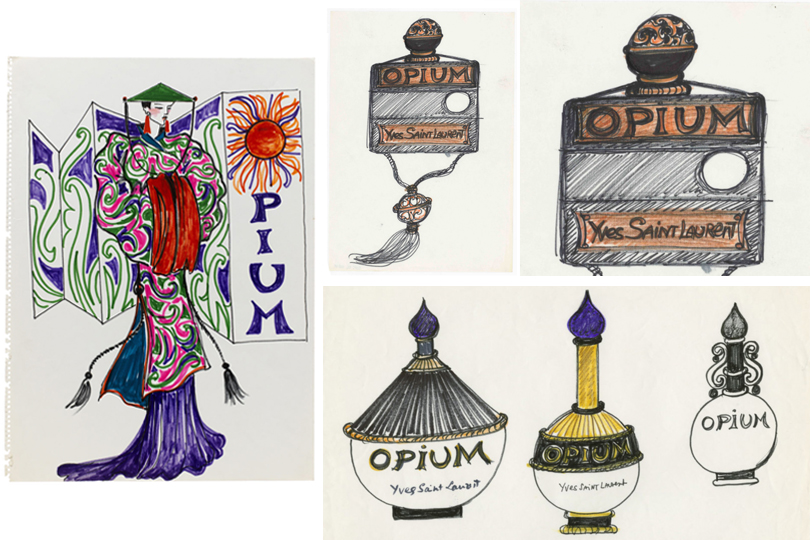
The Oriental theme was carried into its packaging design as well – the red plastic container holding the perfume’s glass vial, designed by Pierre Dinand, was inspired by Japanese inro, the small Japanese lacquered cases that were worn hanging from the obi and held perfumes, herbs and medicines.
The fragrance itself was an unusual blend of scents that had been “inspired” by the Orient, and was created by perfumers Jean Amic and Jean-Louis Sieuzac under the direction of Mr. Saint Laurent. Opium’s top notes are a mixture of fruit and spices, with mandarin orange, plum, clove, coriander and pepper, as well as bay leaf. Its floral middle notes consist predominantly of jasmine, rose and lily of the valley, in addition to carnation, cinnamon, peach and orris root. It is underlined by a sweet woody base note containing sandalwood, cedarwood, myrrh, opopanax, labdanum, benzoin and castoreum, in addition to amber, incense, musk, patchouli, tolu and vetiver.
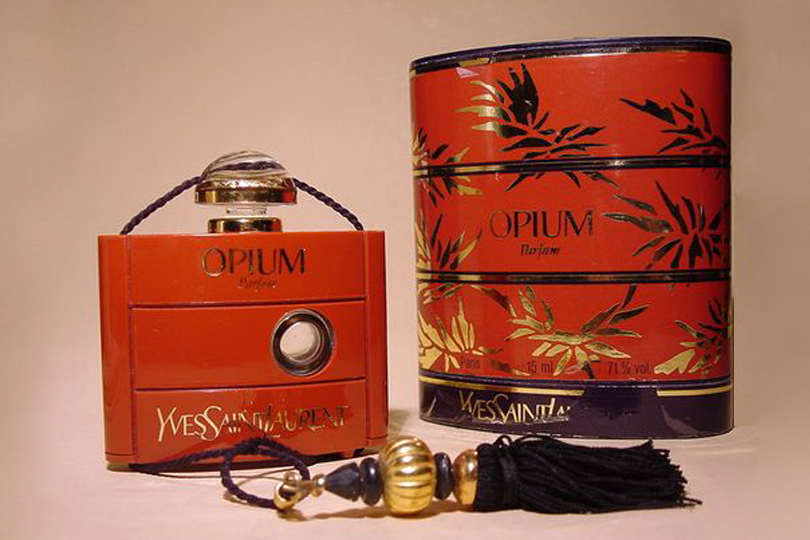
“After the fragrance Y [the designer’s first fragrance, which was released in 1964], I wanted a lush, heavy and languid perfume. I wanted Opium to be captivating, and I wanted its scent to evoke everything I like: the sophisticated Orient, imperial China and exoticism,” influential fashion editor André Leon Talley wrote in “YSL, on Opium,” from the September 18, 1978, edition of Women’s Wear Daily.
It wasn’t the perfume’s inspiration that caused a scandal…at least initially. After all, the idea of a perfume inspired by the Orient was nothing new in the world of fragrances: in 1913, Paul Poiret had launched Nuit de Chine by the Parfums de Rosine in a jade-colored bottle recalling a Chinese tobacco container.
So, what was so controversial about Opium? Well, first, there was the ad campaign, which may be tame by today’s standards but in the late 1970s was shocking for its overt sexuality.
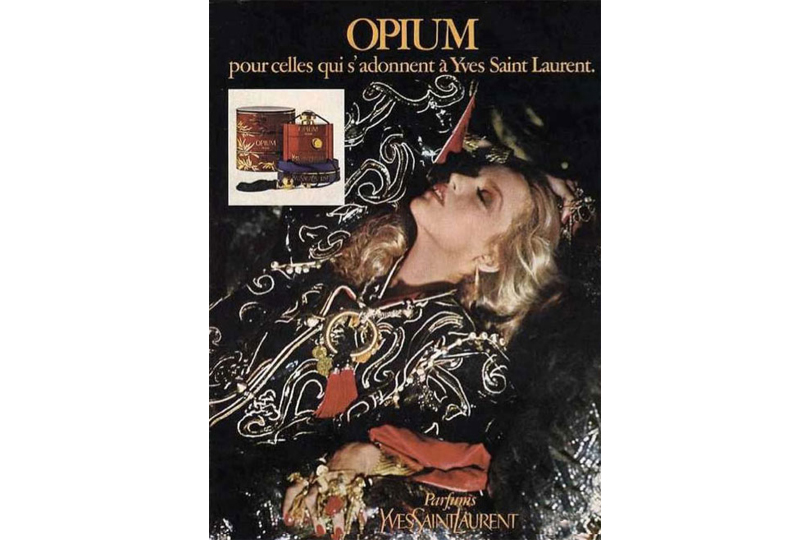
The provocative ads for the Opium fragrance featured Hall on a luxurious sofa, surrounded by opulent accessories and decorations, while her head was thrown back, presumably in ecstasy from the high of sex, drugs…or simply the scent. The ads were unlike anything else at the time, and their exaggerated luxury and sexuality set the precedent for their successors, as the brand maintained the overtly sexual and Oriental theme for years.
But the real controversy started when the scent had its North American launch party in 1978 with a party held aboard the tall ship called Peking, which was manned by one of Mr. Saint Laurent’s fellow Studio 54 regulars, Truman Capote, and berthed at New York City’s South Street Seaport in the East Harbour. The bash, which was thrown by the brand, was scandalous and a preview of the decadence that would come to be associated with Opium. Banners of red, gold and purple hung alongside a thousand-pound statue of the Buddha. Chinese lanterns lit the way for Cher, Halston and some 800 guests who greeted Mr. Saint Laurent and his latest creation, already a top-selling fragrance in France.
The party made all of the society pages, which is what prompted the initial scandal, especially in the United States. Mr. Saint Laurent purposely chose to name the fragrance Opium in reference to a drug from the Orient, and after its North American release, a group of Chinese-Americans demanded a change of the name and a public apology from Mr. Saint Laurent for “his insensitivity to Chinese history and Chinese American concerns.” They formed a committee called the American Coalition Against Opium and Drug Abuse, which expressed outrage at the choice of a name representing “a menace that destroyed many lives in China.” While the coalition failed to prevent the North American launch of the fragrance, it was successful in having the slogan “For those who are addicted to Yves Saint Laurent” changed to “For those who adore Yves Saint Laurent.”
For the most part, the fashion house ignored the controversy and any other rumblings of cultural appropriation, which in part actually helped the perfume’s publicity, with the perfume soon becoming an astonishing success. Stores were unable to keep it on their shelves, and in France the brand was unable to keep up with demand, which resulted in clients paying one year in advance to ensure that they would get their own Opium bottle when the time came.
By the time the initial controversy died down, sales in Europe had reached US$30 million…in one year alone. The success was similar in North America. Opium was the best launch of the year, bringing in US$3 million in sales from September 1978 to June 1979.
That Sophie Dahl ad campaign
The initial Opium controversy in the late 1970s died down as the success of the fragrance took over and lingered for years to come. Opium’s sales never really dipped even as the fragrance world began to expand, and it would find its way back to the centre of controversy a few more times, including being banned in one Australian state.
A 1992 television commercial, which was directed by David Lynch, raised eyebrows – and conservative outrage – when the surrealist director featured a woman seductively caressing her neck, obviously feeling intense pleasure because (it could be inferred) she was using the perfume as though it were a drug. But that was nothing compared to what was to come a few years later.
In 1999, Kering purchased Yves Saint Laurent and hired Tom Ford to design its ready-to-wear collection, while Mr. Saint Laurent himself would design its haute couture collection. Tom Ford, who regularly courted controversy in the early years of his career, was the mastermind behind the brand’s marketing initiatives – including a controversial Opium ad campaign that was released a year after he started with the fashion house.
In October 2000, an advertising campaign for Opium was released featuring model Sophie Dahl lying on her back wearing only a pair of stiletto heels and some jewellery, seemingly in the throes of ecstasy, with her legs spread apart as she covers one of her nipples with her hand. The ad campaign, which was conceived by Ford and shot by photographer Steven Meisel, was everywhere around the globe, from print ads in fashion magazines to billboards and posters in bus shelters. It did not go over very well.
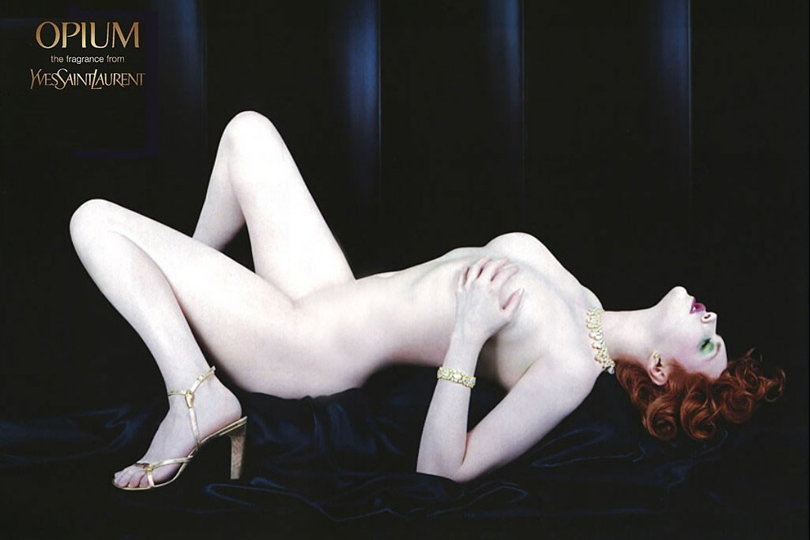
The ads were immediately banned in numerous countries around the globe, and the campaign became the only one by a fashion label to be included in the Advertising Standards Authority’s international list of the 10 most complained-about promotions of all time. The ASA declared that the Yves Saint Laurent image was “sexually suggestive and, in an untargeted medium, likely to cause widespread offence.”
The controversy surrounding the “degrading” Opium ad also reignited another controversy for the French fashion house: Opium was a blatant example of the commodification and fetishism of the Orient, which was centred around the perceived sensuality, exoticism and fetishism of the East, and all available for purchase by Western audiences.
As if the perfume needed any more controversy, in that same year the People’s Republic of China banned the scent entirely, deeming it to be both an offensive reminder of the opium wars and a “spiritual pollution for the younger generation.”
Sultry, seductive and successful
For his part, Mr. Saint Laurent denied any negative connotations and defended his choices, saying: “I thought of poetry, of the exotic, of Rimbaud, of Beaudelaire, of beauty, sensuality and dreams.” Those dreams continue today, as Opium remains the best-selling fragrance from the luxury fashion brand and one of the most iconic scents of all time. Almost 50 years later, sales have not diminished, and Opium remains one of the top 10 bestselling perfumes around the world. Along with Chanel No. 5, it is the only fragrance to have achieved this.
Opium is not only one of the world’s most popular fragrances; it is the inspiration for many other scents. Yves Saint Laurent’s Black Opium, for example, was released in 2014 and inspired by the 1977 blockbuster fragrance with hopes of reaching a new, younger consumer, according to L’Oréal executives (the cosmetics division of Yves Saint Laurent had been sold to L’Oréal at the end of 2008). That iteration is billed to have the first floral coffee fragrance – a reference to addiction, a key theme in the original.
But nothing is like the original. Yves Saint Laurent’s Opium fragrance remains sultry, seductive and very successful at holding onto the title of one of the most popular fragrances of the 20th century, despite – or because of – the controversies surrounding it.
Mr. Saint Laurent, who was no stranger to controversy throughout his career, certainly appreciated it and recognized its selling power. After all, when Opium was first launched, he wrote in the press kit: “I chose Opium for the name of this fragrance because I hope very much that it will diffuse through its incandescent powers, divine fluids, magnetic waves, and the things that most appeal to the heart. The charms of seduction, which give birth to passionate love, when you fall head over heels, fatal ecstasy… ”
![]()
Want more? You can read other stories from our The Story Of series right here.

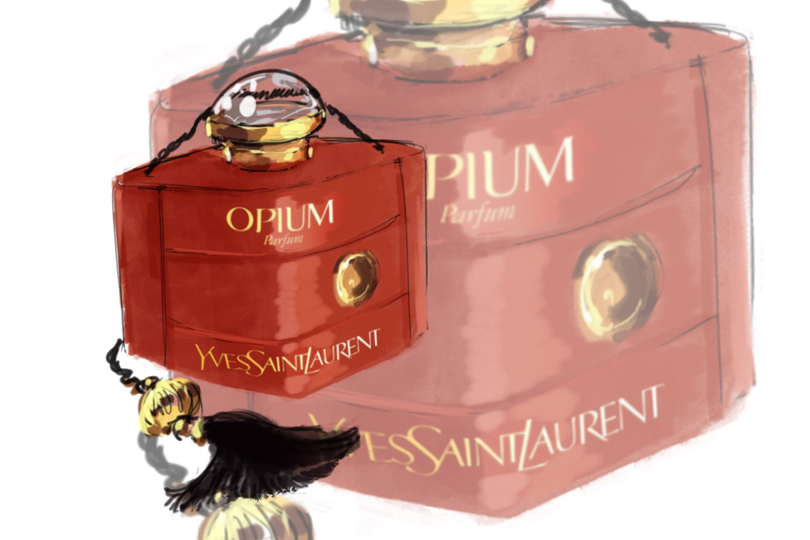

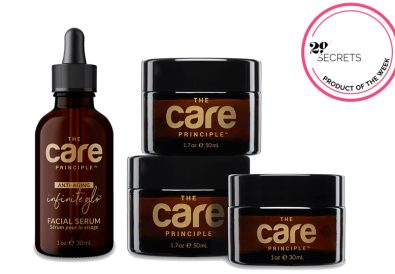
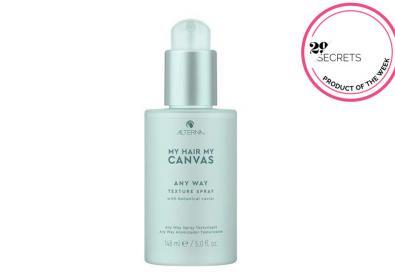


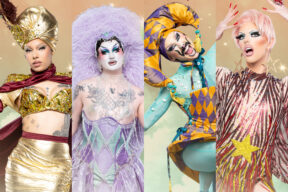





I have been wearing Opium since 1978 and I would love the original version back. Why was the formulary changed?
your perfume bottles ARE TOO CLOSE in style.. I purchased the Black Opium thinking it was black opium; only to find out that it was NOT! Not a happy shopper. same size bottle UPC#38u903w (Red in colour) NOT WHAT I wanted… I would appreciate a refund of some sort please… I tried to return it; but that didnt go over toooooo well. Maryellen 702-978-2532